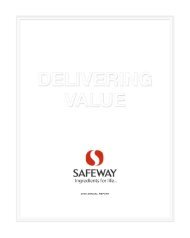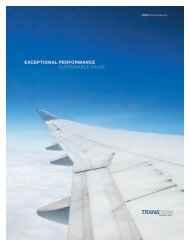Bemis Company 2007 Annual Report - IR Solutions
Bemis Company 2007 Annual Report - IR Solutions
Bemis Company 2007 Annual Report - IR Solutions
You also want an ePaper? Increase the reach of your titles
YUMPU automatically turns print PDFs into web optimized ePapers that Google loves.
Research and Development<br />
Our efforts to introduce new products continue at a steady pace and are an integral part of our daily plant operations. Our<br />
research and development engineers work directly on commercial production equipment, bringing new products to market without the use<br />
of pilot equipment. We believe this approach significantly improves the efficiency, effectiveness and relevance of our research and<br />
development activities and results in earlier commercialization of new products. Expenditures that are not distinctly identifiable as<br />
research and development costs are included in costs of products sold.<br />
Interest Expense<br />
Interest expense increased modestly during <strong>2007</strong> with slightly higher debt levels. The increase in interest expense in 2006<br />
reflects higher interest rates in 2006 compared to 2005. The percentage of variable rate debt included in total debt is about 64 percent in<br />
<strong>2007</strong>, 59 percent in 2006, and 62 percent in 2005. The effective interest rate was 5.9 percent in <strong>2007</strong>, 5.9 percent in 2006, and 4.9 percent<br />
in 2005.<br />
Other Costs (Income), Net<br />
In <strong>2007</strong>, other costs (income) included $28.3 million of financial income, about half of which relates to interest income on cash<br />
held at non-U.S. locations. The remainder of the financial income is generated from fiscal incentives for certain flexible packaging<br />
locations and is considered as a part of flexible packaging operating profit. These fiscal incentives are associated with net sales in South<br />
America and are expected to continue to grow at a modest pace over the next few years in conjunction with sales growth in that region.<br />
In 2006, other costs (income) included $18.3 million of restructuring and related charges, which were more than offset by financial<br />
income of $18.0 million and a $4.5 million favorable resolution of a litigated foreign excise tax liability. In 2005, net other costs<br />
primarily reflect interest income offset by currency exchange losses.<br />
Minority Interest in Net Income<br />
Minority interest in net income is primarily associated with the accounting for the outstanding preferred shares of Dixie Toga<br />
that were not acquired in connection with the January 2005 business acquisition. Our ownership in Dixie Toga had increased from<br />
approximately 80 percent to approximately 86 percent as of December 31, 2005. In April 2006, we acquired the remaining minority<br />
interest in our three Mexican joint ventures which further reduced minority interest in net income. There were no ownership changes in<br />
<strong>2007</strong>.<br />
Income Taxes<br />
The difference between our overall tax rate and the U.S. statutory rate of 35 percent in each of the three years presented<br />
principally relates to state and local income taxes net of federal income tax benefits. Our effective tax rate was 36.5 percent for <strong>2007</strong>, a<br />
decrease from our effective tax rate of 38.3 percent for 2006 and 41.2 percent in 2005. This lower tax rate reflects benefits related to<br />
dividends from a foreign subsidiary, the increasing impact of U.S. tax incentives for manufacturing companies, and a change in the<br />
geographic mix of pretax income. During 2005, an additional $6.0 million of tax expense was recorded as a result of the repatriation of<br />
international subsidiary earnings under the American Jobs Creation Act of 2004, increasing the effective tax rate for 2005 from 39.0<br />
percent to 41.2 percent.<br />
Liquidity and Capital Resources<br />
Debt to Total Capitalization<br />
Debt to total capitalization (which includes total debt, long-term deferred tax liabilities and equity) was 32.9 percent at<br />
December 31, <strong>2007</strong>, compared to 33.0 percent at December 31, 2006 and 35.7 percent at December 31, 2005. Total debt was $843.3<br />
million, $789.8 million, and $844.1 million at year-end <strong>2007</strong>, 2006 and 2005, respectively.<br />
Credit Rating<br />
Our capital structure and financial practices have earned <strong>Bemis</strong> <strong>Company</strong> long-term credit ratings of “A” from Standard &<br />
Poor’s and “Baa1” from Moody’s Investors Service, and a credit rating of “A-1” and “Prime-2” for our commercial paper program from<br />
Standard & Poor’s and Moody’s Investor Service, respectively. Our strong financial positions and credit ratings are important to our<br />
ability to issue commercial paper at favorable rates of interest.<br />
Sources of Liquidity<br />
Cash provided by operations was $406.2 million for the year ended December 31, <strong>2007</strong>, compared to $349.0 million in 2006<br />
and $280.4 million in 2005. Cash provided by operations in each of the years ended December 31, 2006 and 2005 was reduced by<br />
voluntary pension contributions to our U.S. pension plans of $24.0 million and $35.0 million, respectively. While no contributions were<br />
required for our U.S. pension plans in <strong>2007</strong>, we continue to monitor the funded status of all pension plans and will evaluate the benefits of<br />
future voluntary contributions subject to available liquidity.<br />
In addition to using cash provided by operations, we issue commercial paper to meet our short-term liquidity needs. At yearend,<br />
our commercial paper debt outstanding was $161.5 million. Based upon our current credit rating, we enjoy ready access to the<br />
commercial paper markets. While not anticipated, if these markets were to become illiquid or if a credit rating downgrade limited our<br />
ability to issue commercial paper, we would draw upon our existing back-up credit facility. In September 2004, we renegotiated our<br />
back-up credit facility to extend the term to September 2009. This credit facility provides $500 million of available financing supported<br />
by a group of major U.S. and international banks. Covenants imposed by this bank credit facility include limits on the sale of businesses,<br />
minimum net worth calculations, and a maximum ratio of debt to total capitalization. In addition to funds available under this credit<br />
facility, we also have the capability of issuing up to approximately $100 million of Extendable Commercial Notes (ECNs), which are<br />
short-term instruments whose maturity can be extended to 390 days from the date of issuance. If these credit facilities and ECNs were no<br />
13







